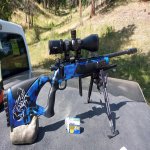Thanks, Jerry.
To clarify, what tuning steps are you choosing? Tuners or something else?
If the reference is to tuners, are you changing settings as you go? Are you changing tuner settings by the ammo used? Are you changing tuner settings with distance?
When you refer to adjusting according to season/temps/weather, are these also with regard to tuner adjustments?
Simple answer is... YES. All the same steps are taken.. just under different bore conditions and distances.
I am now a fan of tuners cause the supply of ammo and choices has tanked. I would prefer to not have to run one but you make the ammo you have work as well as you can.
Once set, I do not adjust my tuner during a match... in fact, I will not adjust it during the season it was tuned in.
Rimfire is very temp sensitive so as weather changes and ammo changes, you tune accordingly.... thought process is similar to tuning offered by reloading
It is a dynamic system and as long as you are testing at targets 100yds and beyond, it will be very clear if your set up is working or not. I have seen combos work at 265m and crap out at 320m and beyond. Test and count every shot... and miss.
WRT to precision and accuracy, podium prs rifles are both. We tune to find the tightest and most stable "cone of accuracy" all the way out to 400m. This is a system question and if you ever want to get into the game, happy to help you get setup from rifle, barrel, optics and possible ammo options.
WRT to cost, that is entirely up to the end user. Cost doesn't ensure success... the right parts do and sometimes, that doesn't need to cost alot of money. There continues to be some very expensive parts that don't work all that well... but that is mostly by design.
I competed with a 10/22 and did very very well out to 400m against all the fancy bolts. My build uses a factory 10/22 action ... cheap (by comparison) to recreate.

My current bolt rifle which has done very well (see 100yd challenge) starts off as a $220 rifle.... just got lucky that these are built with the right bits and bobs to work for this game given some TLC and DIY updates/touches. Most factory rifles are not suitable.... until lots are changed.
Shooting rimfire LR has alot of challenges starting with the ammo but we are learning lots and are at the point where the machine can get the job done... now to find the ammo that is 'good enough'
Jerry










































































